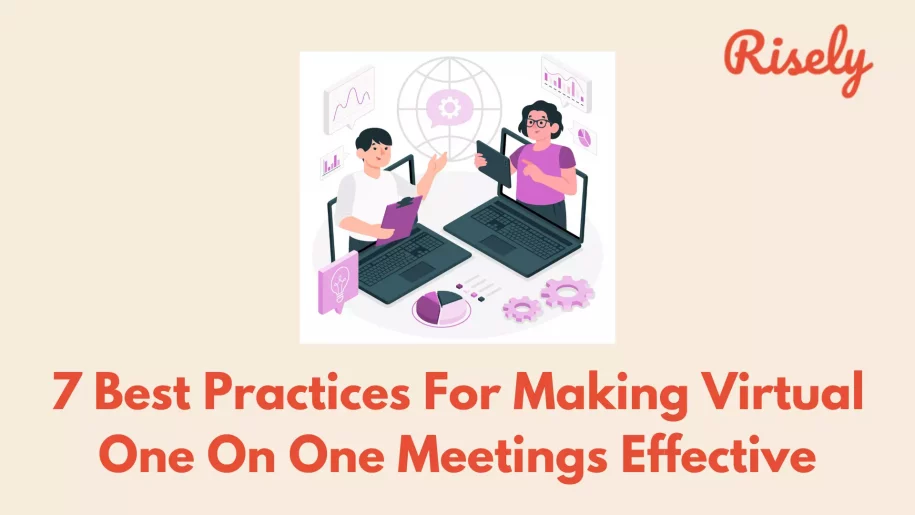7 Best Practices For Making Virtual One On One Meetings Effective
Are you tired of never-ending email chains and miscommunications within your team? Have you ever found yourself struggling to build a connection with your colleagues while working remotely? With remote work becoming the new normal, virtual one on one meetings have become essential to employee management. It helps managers connect with their team members personally and address any issues or concerns they may have. In this blog, we will discuss seven best practices that can help you make virtual one on one meetings effective. We will cover the importance of these meetings, preparing for them, and how to conduct them effectively. By following these practices, you can ensure that your virtual one on one meetings are productive, engaging, and help build strong relationships with your team members. Let’s dive in!Importance of Virtual One-on-One Meetings
In today’s world, remote work has become the new norm, and virtual communication has become an essential part of our daily work routine. Amid this new work environment, one-on-one meetings are more crucial than ever. Although face-to-face meetings may not always be possible, virtual one on one meetings allow managers, team leaders, and employees to connect, collaborate, and communicate effectively. Here are some of the key reasons why virtual one-on-one meetings are essential for a successful remote work environment:- Building Relationships: Virtual one on one meetings allow team members to build rapport, establish personal connections, and promote team bonding. Building these relationships can lead to better team collaboration, enhanced teamwork, and increased trust, even when working remotely.
- Clear Communication: Communication is key to any successful work environment, and virtual one on one meetings are essential to achieving clear and concise communication. These meetings help clarify goals, expectations, feedback, and progress, ensuring everyone is aligned and on the same page.
- Employee Engagement: Virtual one on one meetings allow employees to voice their thoughts, ideas, and concerns. Virtual one-on-one meetings can increase employee engagement, motivation, and job satisfaction by providing a platform to communicate openly.
Preparing for a Virtual One-on-One Meeting
Setting the stage for a successful virtual one-on-one meeting requires adequate preparation. Such as;Scheduling the Meeting and Setting an Agenda
Scheduling a virtual one-on-one meeting can be challenging, especially if both participants have different schedules and are in different time zones. Setting a clear agenda beforehand is essential to ensure the meeting runs smoothly. This helps both members focus on achieving their objectives efficiently. Consider scheduling the meeting at a time that works best for both members, considering any work schedule or time zone differences. Sending out a calendar invite with the agenda and any necessary materials ahead of time helps everyone stay on track and be prepared for the conversation.Choosing the Right Video Conferencing Platform
Selecting the right video conferencing platform is essential for virtual one on one meetings to be effective. A poor-quality platform can cause disruptions in communication and lead to unproductive conversations. Factors such as ease of use, security features, and device compatibility should be considered when choosing a platform. Popular options like Zoom, Microsoft Teams, and Google Meet provide features like screen sharing, recording options, and file transfer, making them ideal for virtual one-to-one meetings. Before the meeting starts, it is crucial to test the selected platform to avoid last-minute technical difficulties. Communicating with participants ahead of time to ensure they have access and understand how to join the video call can also contribute to a smooth meeting experience.Other Interesting Reads
Creating a Productive Meeting Space
Creating a productive meeting space ensures your virtual one on one meeting succeeds. As you prepare for an in-person meeting, finding a quiet, dedicated space to focus and avoid distractions is important. This can be especially challenging when working from home or in a shared workspace, so take some time to set up your environment beforehand. Consider testing your internet connection and audiovisual equipment to ensure everything works properly. A reliable connection and clear audio and video can help the conversation flow smoothly and prevent technical difficulties from interrupting the meeting. Additionally, preparing an agenda ahead of time can help keep the discussion on track and ensure that all important topics are covered. Encouraging open communication and active listening can make the most of your virtual one on one meeting.
7 Best Practices For Making Virtual One On One Meetings Effective
Here are seven best practices for making virtual one-on-one meetings effective:- Set an agenda: To make the conversation stay focused and productive, set a well-defined agenda outlining the topic of discussion. It helps both the members to prepare and provides a clear structure for the meeting.
- Establish expectations: Clarify the purpose and objectives of the meeting at the beginning. Discuss timelines, goals, and roles to ensure that both members have a mutual understanding of what needs to be accomplished during the meeting.
- Encourage participation: Actively encourage participation from both sides by asking open-ended questions, seeking input, and providing opportunities for feedback. This fosters a collaborative environment, enhances engagement, and promotes effective communication. Ensure that the focus remains on employee’s professional development.
- Use video conferencing: Opt for video conferencing instead of audio-only calls. Seeing each other’s facial expressions and body language helps to establish a personal connection and enhances understanding. It also prevents miscommunication that can occur in written or verbal communication alone.
- Take breaks: Virtual meetings can be mentally draining due to screen time. Incorporate short breaks to allow participants to rest their eyes and recharge. It helps maintain focus, attention, and overall productivity during the meeting.
- Follow up: After the meeting, send a summary or minutes to all participants, outlining key points discussed, decisions made, and any action items or deadlines. This ensures clarity and accountability, reducing the chance of misunderstandings or missed tasks.
- Seek feedback: Ask for feedback from each other on the effectiveness of the meeting. Inquire about what worked well and what could be improved. Incorporating feedback helps refine future meetings and ensures continuous improvement in the virtual one on one communication process.
Benefits of Virtual one on one meetings
Virtual one on one meetings offer several benefits, including:- Convenience: One-on-one meetings can be held from anywhere, anytime, eliminating the need for travel or in-person meetings.
- Flexibility: Virtual meetings allow more flexibility in scheduling, making finding a time that works for both members easier.
- Improved Focus: Virtual one-on-one meetings allow focused and productive conversations without distractions from other colleagues or the office environment.
- Enhanced Personal Connection: Despite the physical distance, virtual meetings can foster a personal connection, providing a more comfortable environment for open and honest communication.
- Time-Saving: Virtual one-on-one meetings are often shorter than in-person meetings, saving time and increasing efficiency for both members.
Conclusion
Virtual one-on-one meetings are a great way to build relationships, boost employee morale, and improve productivity. By preparing for your virtual meeting, you can ensure it is productive and efficient. Focus on the employee’s needs and goals, clarify expectations and objectives, set realistic priorities and deadlines, demonstrate empathy and support, and encourage proactive problem-solving. The benefits of virtual one-on-one meetings cannot be overstated; they help build trust between managers and employees, increase accountability, enhance communication skills, and promote teamwork. To learn more about how to make your one-on-one meetings effective and become a better manager, Sign up for Risely-Manager’s Buddy.Are you following these one-on-one meeting best practices, or missing some on the way?
Test your skills now with the free effective one-on-one meeting self-assessment for managers.
FAQs
What do you say in a 1 to 1 meeting?
You can discuss goals, challenges, progress, feedback, and personal development in a one-on-one meeting. It’s a chance to build rapport, address concerns, and align on expectations.
What are the types of one on one meeting?
The types of one-on-one meetings include performance check-ins, coaching sessions, career development discussions, goal-setting meetings, problem-solving sessions, and relationship-building conversations.
What is the purpose of a 1 on 1 meeting?
A one-on-one meeting aims to foster open communication, build relationships, provide feedback, align on goals, address challenges, and support professional development in a personalized and focused setting.
Other Related Blogs
Shivani Pande Uncovers the Making of a Manager
Shivani Pande Uncovers the Making of a Manager “Be a good person, but don’t always be a nice person.” That mantra guides Shivani Pande in her quest to create great…
One-on-one Meetings That Don’t Make Your Team Sigh
One-on-one Meetings That Don’t Make Your Team Sigh One-on-one meetings! If you are anywhere close to a performance review session, your calendar might be crowded by the team. But there’s…
One-on-One Meetings: The Most Essential Tool In Any Manager’s Arsenal
One-on-One Meetings: The Most Essential Tool In Any Manager’s Arsenal One of the most critical aspects of effective people management is regular and frequent one-on-one meetings. These meetings are essential…







